Caryn’s Thoughts
 The pilots of the war birds were brave men. They were tasked with staying the course while under heavy anti-aircraft fire and flak. That would be a major undertaking for most of us because in that situation, all our mind can think to do is to turn and run. These men had to stay in place so they could make the bomb runs, or protect those who were. Of course, there were gunners tasked with keeping the enemy planes at bay, but they couldn’t fly the plane to get you home.
The pilots of the war birds were brave men. They were tasked with staying the course while under heavy anti-aircraft fire and flak. That would be a major undertaking for most of us because in that situation, all our mind can think to do is to turn and run. These men had to stay in place so they could make the bomb runs, or protect those who were. Of course, there were gunners tasked with keeping the enemy planes at bay, but they couldn’t fly the plane to get you home.
United States Army Air Force Lieutenant William R Lawley Jr, was a pilot on a B-17 Bomber on February 20, 1944. It was the first day of “Big Week,” and Lieutenant Lawley’s Boeing B-17 Flying Fortress was at the head of a formation of one thousand bombers sent to bomb Germany’s production and aircraft manufacturing facilities. “Big Week” was the Allied plan to spend seven days ruthlessly dropping explosives onto enemy aircraft production facilities deep behind enemy lines. Day and night, wave after wave of American B-17 Flying Fortresses, B-24 Liberators, and British Lancasters blasted shipyards, railroad junctions, power plants, airfields, steel production facilities, dams, and military bases relentlessly, igniting everything from ball bearing plants to oil refineries up into towering explosive fireballs, to make it impossible for anyone in Germany to build a working fighter plane.
Suddenly, the call rang out, “Bandits, incoming, three o’clock high!” Immediately, the gunners began shooting to fight off the enemy planes, while Lawley held the plane steady. The loud, rumbling propellers roared as he pushed open the throttle and smashed through a thick black cloud of anti-aircraft smoke at nearly three hundred miles an hour, all while keeping in tight formation with hundreds of other B-17s. A pair of Nazi Focke-Wulf 190 fighter planes screamed by, ripping off thousands of rounds from twin-linked machine guns and heavy 20mm autocannons. Black puffs of enemy artillery popped up all around Lawley’s massive aircraft craft. The enemy fighters screamed past at speeds of over four hundred miles an hour. As the gray Nazi fighters dove down towards another squadron of American bombers below, Lawley’s starboard waist gunner zeroed in on them with his .50-caliber machine gun with a quick burst of tracer fire, but had to release the trigger as a pair of American P-47 Thunderbolt fighter planes dropped in to chase them. These Bomber raids were nothing new for Lawley. Born in Alabama, this 23 year old veteran pilot had already flown nine missions over Germany in the last year. This was his tenth mission, but the first at the controls of a brand-new B-17, nicknamed Cabin in the Sky III, because the first two Cabin in the Sky aircraft been blown up.
Suddenly, voices on the intercom called out enemy fighters, this time diving down from behind. With the sun at their backs, blinding the tail gunner, the Focke-Wulfs ignored the deadly clouds of flak ripping apart the sky around them and hurtled straight into the B-17 formation. Their 20mm cannons struck home at one of Lawley’s wingmen, catching her engines on fire and dropping her out of the sky like a brick. Another flak explosion hit even closer, rocking Cabin in the Sky III and peppering one of the engines with shards of metal, causing it to burst into flames. Lawley ordered the copilot to shut it down and kept moving. More calls came in. “Six o’clock low.” “Three o’clock level.” The Nazis were everywhere, attacking from seemingly every direction at once. The B-17s stuck close together, knowing that the only way to survive was to stay close and lay down heavy fields of  machine gun fire. As his gunners fired in every direction, Lawley looked through his cockpit window to see a fleet of twenty or so 190s drop down in front of him, pick out targets, and open fire. With a deafening crash, a 20mm high explosive autocannon shell bust through the front window of the pane, exploding in the cockpit. Everything went black.
machine gun fire. As his gunners fired in every direction, Lawley looked through his cockpit window to see a fleet of twenty or so 190s drop down in front of him, pick out targets, and open fire. With a deafening crash, a 20mm high explosive autocannon shell bust through the front window of the pane, exploding in the cockpit. Everything went black.
Lawley snapped awake seconds later, his ears ringing. Alarms were going off all across his console, which was now riddled with shards of shrapnel. His right arm was shattered. Through blurry vision, Lawley saw his co-pilot slumped over dead, his body laying on the control stick pushing it forward, putting the plane was in a steep dive. The loaded bomb racks made matters worse. The pilot-side window was smashed, and broken glass had gone into Lawley’s face, arms, and side. The windshield was so smeared with blood and oil that he could barely see out of it. Another engine was one fire. Lieutenant William Lawley didn’t panic. He did his job. Determined to keep his plane and his crew alive, the veteran USAAF pilot reached out with his shattered right arm, grabbed his dead co-pilot, and somehow pulled him back off the controls. Then, with just his left hand, he manually fought a 15-ton bomber aircraft out of a ninety-degree nosedive at 12,000 feet, leveled it off, and shut down the second burning engine. Looking up, he saw the Focke-Wulf pilots circling around for another pass, so this grim warrior made an evasive turn, dove the plane down into the cloud cover, and accelerated out of there as fast as he could. Other B-17s in the formation had radioed Cabin in the Sky III as Killed in Action, but somehow William Lawley managed to evade the enemy fighters and get the heck out of Leipzig. He flew across Germany, dodging enemy AA positions, then flew in low over the French countryside and ordered the surviving eight members of his crew to grab parachutes and bail out. It was then that he learned all eight crewmen were wounded in the attack, and that two of them were hurt so bad they couldn’t possibly go skydiving right now. Lawley said, “Ok. I’m going to get us home then.” Nobody jumped out of the plane.
The bombardier eventually got the racks unstuck and released his bombs over an unimportant part of the French countryside, but before long another squadron of Me-109 fighters picked up the wounded B-17 on radar and came swooping in for the kill. With his guys running to their guns to bark .50-caliber machine gun fire, Lawley hammered the stick of his crippled plane, dodging and evading with one arm and somehow eluding enemy fighters one more time. In the process, however, he had to use more fuel than he’d have liked, and one of the two remaining engines was now almost completely out of gas. Once the coast was clear and the Messerschmitt fighter planes were gone, Lawley leveled off the plane and promptly passed out from loss of blood. This was the days before autopilot, and Lawley was the only guy who knew how to fly the plane. Luckily his navigator figured out what was up and woke him up pretty much right away.
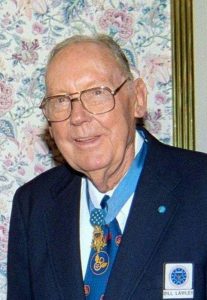
Cabin in the Sky III somehow reached the English Channel against all odds, received emergency landing permission from a Canadian fighter base on the English coast and, just in case you’re wondering how the heck this could possibly get any worse, when William Lawley hit the button to drop his landing gear, it didn’t deploy. So, limping in with three burned-out engines, “feathering” his only working one by pumping it off and on with small amounts of gas, half blinded by broken glass, exhausted from loss of blood, and with no landing gear, eight wounded crew members, and one good arm, Lieutenant William Lawley attempted to crash land a 15-ton B-17 on a grass airfield about the size of a soccer pitch. He came in hard on his belly, sliding across the airfield, finally coming to a rest just outside the Canadian barracks. Every member of his crew survived. Lawley walked out of the wreckage, spend a few weeks in the hospital, and make a full recovery. He successfully piloted four more bombing missions before the war was over. Did he earn his Modal of Honor? Without a doubt!!
 When the Great Depression hit, people in the upper-middle class, like doctors, lawyers, and other professionals, saw their incomes drop by 40%, but the middle class and low income Americans found themselves with nothing. They had no jobs and no money, and even if they did have those things, they couldn’t afford the things they needed. The prices for everything from food to clothing were much more than their meager income could buy much of. People began to move from place to place looking for a job…any job. The problem was that there were very few jobs, and lot of people standing in line to get them. The average American lived by the Depression-era motto: Use it up, wear it out, make do, or do without. People had to learn to be frugal. Clothes were patched when the started to wear out. People planted gardens and even kept little gardens in their kitchen. They stayed home, instead of evenings out. They were always in a private struggle to keep their cars or homes.
When the Great Depression hit, people in the upper-middle class, like doctors, lawyers, and other professionals, saw their incomes drop by 40%, but the middle class and low income Americans found themselves with nothing. They had no jobs and no money, and even if they did have those things, they couldn’t afford the things they needed. The prices for everything from food to clothing were much more than their meager income could buy much of. People began to move from place to place looking for a job…any job. The problem was that there were very few jobs, and lot of people standing in line to get them. The average American lived by the Depression-era motto: Use it up, wear it out, make do, or do without. People had to learn to be frugal. Clothes were patched when the started to wear out. People planted gardens and even kept little gardens in their kitchen. They stayed home, instead of evenings out. They were always in a private struggle to keep their cars or homes.
Paint was too expensive, so home fell into disrepair. As things got worse, things began to wear out, and people didn’t get rid of the junk. They simply put it out in the yard. I’m sure that they realized that every piece of junk had parts in it that could be used for repairs to something else. Everything could be reworked. They used the 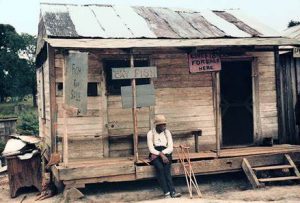 backs of worn-out overall legs to make pants for little boys and overalls for babies. They didn’t have disposable diapers back then. They made diapers and underwear out of flour and sugar sacks. When the older kids outgrew their clothes, but they were too big for the younger kids, they made smaller clothes out of bigger hand-me-downs. If their shoes wore out before a year, the children went barefooted. Many people resorted to bartering…not only goods for goods, but work for work. They tried to make their homes and their lives pretty, even in depressing times. They used patterned chicken feed sacks to make curtains, aprons, and little girl’s dresses. Worn out socks were kept, so that they could patch another sock. Nothing was thrown away. They saved string that came loose from clothing and added it to a string ball for mending and sewing. Toilet paper was a luxury that many people couldn’t afford, so they used newspaper instead. They saved every scrap of material for making quilts. People learned not to waste anything.
backs of worn-out overall legs to make pants for little boys and overalls for babies. They didn’t have disposable diapers back then. They made diapers and underwear out of flour and sugar sacks. When the older kids outgrew their clothes, but they were too big for the younger kids, they made smaller clothes out of bigger hand-me-downs. If their shoes wore out before a year, the children went barefooted. Many people resorted to bartering…not only goods for goods, but work for work. They tried to make their homes and their lives pretty, even in depressing times. They used patterned chicken feed sacks to make curtains, aprons, and little girl’s dresses. Worn out socks were kept, so that they could patch another sock. Nothing was thrown away. They saved string that came loose from clothing and added it to a string ball for mending and sewing. Toilet paper was a luxury that many people couldn’t afford, so they used newspaper instead. They saved every scrap of material for making quilts. People learned not to waste anything.
Every part of the food was used. Potato peels were food, not waste. They made soup out of a few vegetables and a scrap of meat…for flavor only. They hunted for rabbits and fished to put what protein they could on the table. When there was nothing more to eat, they had lard sandwiches. I seriously doubt if many people went to 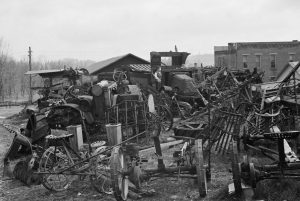 bed with a full stomach, but that didn’t mean that you turned away a stranger who was hungry. These people knew hw bad things were for them, and so they helped their neighbors. Nevertheless, during the Great Depression, suicide rates in the United States reached an all-time high, topping 22 suicides per 100,000 people. The living conditions were deplorable, and many people couldn’t take it. They felt that somehow they were at fault. still, for the majority of Americans, that didn’t mean that they gave up. Neighbor looked out for neighbor, and families came together to support each other, and while the effects of the Great Depression lasted for 12 years, this too passed, and the nation healed again.
bed with a full stomach, but that didn’t mean that you turned away a stranger who was hungry. These people knew hw bad things were for them, and so they helped their neighbors. Nevertheless, during the Great Depression, suicide rates in the United States reached an all-time high, topping 22 suicides per 100,000 people. The living conditions were deplorable, and many people couldn’t take it. They felt that somehow they were at fault. still, for the majority of Americans, that didn’t mean that they gave up. Neighbor looked out for neighbor, and families came together to support each other, and while the effects of the Great Depression lasted for 12 years, this too passed, and the nation healed again.
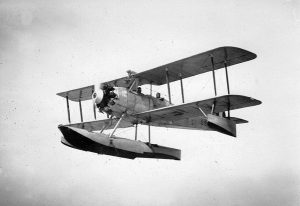 On January 17, 1920, the law prohibiting the use or sale of alcohol in the United States went into effect. Before long, illegal bars, called speakeasies were trying to pass off dangerous locally made industrial alcohol as the real thing, but customers were quickly rejecting the foul-tasting brew. The people were demanding quality, authentic Scotch and other liquor “right off the boat.” Within weeks, organized smuggling of imported whiskey, rum, and other liquor, called Rumrunning began. Among the customers for imported booze from Europe, Canada and the Caribbean were the nation’s bootleggers who ran and supplied thousands of speakeasies. Tops among them were Big Bill Dwyer (dubbed “King of the Bootleggers” by the press) and Mob bosses Charles “Lucky” Luciano in New York and Al Capone in Chicago.
On January 17, 1920, the law prohibiting the use or sale of alcohol in the United States went into effect. Before long, illegal bars, called speakeasies were trying to pass off dangerous locally made industrial alcohol as the real thing, but customers were quickly rejecting the foul-tasting brew. The people were demanding quality, authentic Scotch and other liquor “right off the boat.” Within weeks, organized smuggling of imported whiskey, rum, and other liquor, called Rumrunning began. Among the customers for imported booze from Europe, Canada and the Caribbean were the nation’s bootleggers who ran and supplied thousands of speakeasies. Tops among them were Big Bill Dwyer (dubbed “King of the Bootleggers” by the press) and Mob bosses Charles “Lucky” Luciano in New York and Al Capone in Chicago.
Liquor was smuggled in from any country where it was still legal, and the Rumrunners would then have to find new and unique ways to get it to their buyers. Shipments of whiskey from Great Britain traveled to Nassau in the Bahamas and elsewhere in the Caribbean, before being smuggled to America’s East Coast and New Orleans. Whiskey distilled in Canada was smuggled by ship or across land to the West Coast from British Columbia, to the Midwest from Saskatchewan and Ontario, and to the East from Nova Scotia and the French island of Saint Pierre, a liquor smuggler’s hotspot off Newfoundland. Loads of rum from the Caribbean, imported champagne, and other alcohol also made it ashore. Captains of boats loaded with liquor bottles in false bottoms beneath fish bins anchored offshore at designated areas waiting for “contact boats,” small high-speed crafts with buyers who tossed aboard a bundle of large bills bound by elastic bands,  loaded their liquor orders onto their boats and sped to shore to load it onto trucks headed for New York, Boston and other cities. One such stretch of ocean for liquor-selling boats, famously called “Rum Row,” ran from New York to Atlantic City, 12 miles out in international waters to avoid the U.S. Coast Guard.
loaded their liquor orders onto their boats and sped to shore to load it onto trucks headed for New York, Boston and other cities. One such stretch of ocean for liquor-selling boats, famously called “Rum Row,” ran from New York to Atlantic City, 12 miles out in international waters to avoid the U.S. Coast Guard.
The “golden years” of rumrunning were the early 1920s…before Bureau of Prohibition agents, local police and the Coast Guard knew just what liquor smugglers were up to. On the Detroit River, Detroit’s vicious Purple Gang used speed boats to run liquor into town from Windsor, Ontario. They also hijacked the loads their competitors. One infamous Western rumrunner was Roy Olmstead, who shipped Canadian whiskey from a distillery in Victoria in southwestern Canada down the Haro Strait, stashing it on D’Arcy Island on its way to Seattle. Olmstead was making $200,000 a month before Prohibition agents tapped his phone, leading to his arrest and end as a rumrunner in 1924. Individual bootleggers transporting booze by land to Seattle would hide it in automobiles under false floorboards with felt padding or in fake gas tanks. Sometimes whiskey was mixed with the air in the tubes of tires. To fool authorities at the border, a smuggler might have a woman and child inside his car with hidden liquor or even stow it inside a school bus transporting children. Out at sea or on the Great Lakes, rumrunners in schooners or motor boats contended with the Coast Guard, rough weather and frozen water. Even worse were the “go-through guys,” hoodlums armed with pistols and machines guns in speed boats who hijacked the ships, stole cargo, cash, and at times killed rumrunners’ crews and sank their ships.
The fast-moving rumrunners frustrated the Coast Guard so much by 1923 that Commandant William E. 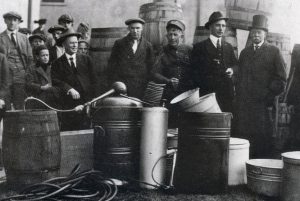 Reynolds asked the federal government for 200 more cruisers and 90 speed boats for patrols to catch up with the contact boats. The agency also added 36 World War I naval ships to enforce Prohibition and employ 11,000 officers and crew. On June 20, 1923, a large fleet of Seaplanes were to be mobilized in an attempt to catch rum smugglers off the Atlantic Coast, it was believed these would be more successful than current means of catching the rum runners who are equipped with very fast boats that are outrunning federal agents. The reality is that they never really stopped the smuggling of liquor into the United States, and in the end, prohibition proved to be a miserable failure. On December 5th, 1933, when the 21st Amendment was ratified, Prohibition was abolished in the United States.
Reynolds asked the federal government for 200 more cruisers and 90 speed boats for patrols to catch up with the contact boats. The agency also added 36 World War I naval ships to enforce Prohibition and employ 11,000 officers and crew. On June 20, 1923, a large fleet of Seaplanes were to be mobilized in an attempt to catch rum smugglers off the Atlantic Coast, it was believed these would be more successful than current means of catching the rum runners who are equipped with very fast boats that are outrunning federal agents. The reality is that they never really stopped the smuggling of liquor into the United States, and in the end, prohibition proved to be a miserable failure. On December 5th, 1933, when the 21st Amendment was ratified, Prohibition was abolished in the United States.
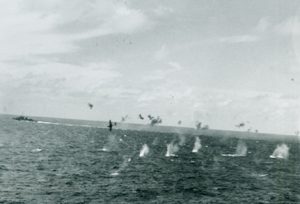 Some of the biggest defeats in any war come from underestimating the enemy or refusing to believe the facts. In the case of Japan it was a little of both. The security of the Marianas Islands, in the western Pacific, was vital to Japan, which had air bases on Saipan, Tinian, and Guam. The United States troops were already battling the Japanese on Saipan, since their arrival there on June 15, 1944. Any further intrusion would leave the Philippine Islands, and Japan itself, vulnerable to US attack. The Japanese needed to maintain their security in the Marianas Islands.
Some of the biggest defeats in any war come from underestimating the enemy or refusing to believe the facts. In the case of Japan it was a little of both. The security of the Marianas Islands, in the western Pacific, was vital to Japan, which had air bases on Saipan, Tinian, and Guam. The United States troops were already battling the Japanese on Saipan, since their arrival there on June 15, 1944. Any further intrusion would leave the Philippine Islands, and Japan itself, vulnerable to US attack. The Japanese needed to maintain their security in the Marianas Islands.
The US Fifth Fleet, commanded by Admiral Raymond Spruance, was on its way northwest from the Marshall Islands. Their mission was to provide backup for the invasion of Saipan and the rest of the Marianas. Whether he knew what was going on or not, 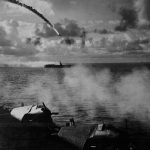 Japanese Admiral Ozawa Jisaburo, decided to challenge the American fleet. He ordered 430 of his planes, launched from aircraft carriers, to attack. The greatest carrier battle of the war was about to begin. The United States picked up the Japanese craft on radar and shot down more than 300 aircraft and sunk two Japanese aircraft carriers. By comparison, the United States only lost 29 of their own planes in the process. Strangely, Admiral Ozawa, believed that his missing planes had landed at their Guam air base. He maintained his position in the Philippine Sea, allowing for a second attack of US carrier-based fighter planes. He made his men sitting ducks!! The secondary attack, commanded by Admiral Mitscher, shot down an additional 65 Japanese planes and sink another carrier. In total, the Japanese lost 480 aircraft…about three-quarters of its total aircraft, not to mention most of its crews. American would dominate the Marianas Islands, and Japan was in deep trouble. The battle was later described as a “turkey shoot.”
Japanese Admiral Ozawa Jisaburo, decided to challenge the American fleet. He ordered 430 of his planes, launched from aircraft carriers, to attack. The greatest carrier battle of the war was about to begin. The United States picked up the Japanese craft on radar and shot down more than 300 aircraft and sunk two Japanese aircraft carriers. By comparison, the United States only lost 29 of their own planes in the process. Strangely, Admiral Ozawa, believed that his missing planes had landed at their Guam air base. He maintained his position in the Philippine Sea, allowing for a second attack of US carrier-based fighter planes. He made his men sitting ducks!! The secondary attack, commanded by Admiral Mitscher, shot down an additional 65 Japanese planes and sink another carrier. In total, the Japanese lost 480 aircraft…about three-quarters of its total aircraft, not to mention most of its crews. American would dominate the Marianas Islands, and Japan was in deep trouble. The battle was later described as a “turkey shoot.”
Not long after this battle at sea, US Marine divisions penetrated farther into the island of Saipan. Two of the 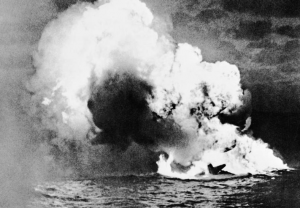 Japanese commanders on the island, Admiral Nagumo and General Saito, both committed suicide in an attempt to rally the remaining Japanese forces. I can’t imagine how that would inspire the forces. It was an act that can only be understood by a sick mind, but their plan worked. Those forces also committed a virtual suicide as they attacked the Americans’ lines, losing 26,000 men compared with 3,500 lost by the United States. Within another month, the islands of Tinian and Guam were also captured by the United States. Due to the disgrace, the Japanese government of Premier Hideki Tojo resigned at this stunning defeat, in what many have described as the turning point of the war in the Pacific.
Japanese commanders on the island, Admiral Nagumo and General Saito, both committed suicide in an attempt to rally the remaining Japanese forces. I can’t imagine how that would inspire the forces. It was an act that can only be understood by a sick mind, but their plan worked. Those forces also committed a virtual suicide as they attacked the Americans’ lines, losing 26,000 men compared with 3,500 lost by the United States. Within another month, the islands of Tinian and Guam were also captured by the United States. Due to the disgrace, the Japanese government of Premier Hideki Tojo resigned at this stunning defeat, in what many have described as the turning point of the war in the Pacific.
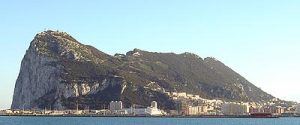 After reading about the rescue of Allied personnel from occupied France by smuggling them through Spain and then to the Rock of Gibraltar, I wanted to know more about this place. The story talked about the tunnels that basically created an underground city in the Rock of Gibraltar. The Rock was basically a huge underground fortress capable of accommodating 16,000 men along with all the supplies, ammunition, and equipment needed to withstand a prolonged siege. The entire 16,000 strong garrison could be housed there along with enough food to last them for 16 months. Within the tunnels there were also an underground telephone exchange, a power generating station, a water distillation plant, a hospital, a bakery, ammunition magazines and a vehicle maintenance workshop. Such a place in World War II would be almost impossible to penetrate with the weapons available in that day and age.
After reading about the rescue of Allied personnel from occupied France by smuggling them through Spain and then to the Rock of Gibraltar, I wanted to know more about this place. The story talked about the tunnels that basically created an underground city in the Rock of Gibraltar. The Rock was basically a huge underground fortress capable of accommodating 16,000 men along with all the supplies, ammunition, and equipment needed to withstand a prolonged siege. The entire 16,000 strong garrison could be housed there along with enough food to last them for 16 months. Within the tunnels there were also an underground telephone exchange, a power generating station, a water distillation plant, a hospital, a bakery, ammunition magazines and a vehicle maintenance workshop. Such a place in World War II would be almost impossible to penetrate with the weapons available in that day and age.
The tunnels of Gibraltar were constructed over the course of nearly 200 years, principally by the British Army. Within a land area of only 2.6 square miles, Gibraltar has around 34 miles of tunnels, nearly twice the length of its entire road network. The first tunnels were excavated in the late 18th century. They served as communication passages between artillery positions and housed guns within embrasures cut into the North Face of the Rock, to protect the interior city. More tunnels were constructed in the 19th century to allow easier access to remote areas of Gibraltar and accommodate stores and reservoirs to deliver the water supply of 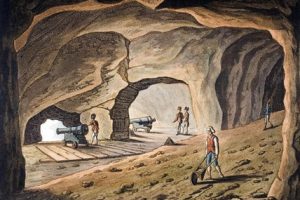
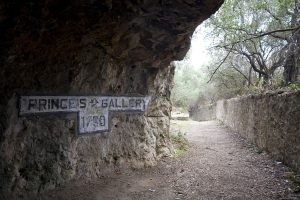 Gibraltar. At the start of World War II, the civilian population around the Rock of Gibraltar was evacuated and the garrison inside the facility was greatly increased in size. A number of new tunnels were excavated to create accommodation for the expanded garrison and to store huge quantities of food, equipment, and ammunition. The work was carried out by four specialized tunneling companies from the Royal Engineers and the Canadian Army. They created a new Main Base Area in the southeastern part of Gibraltar on the peninsula’s Mediterranean coast. It was chosen because it was shielded from the potentially hostile Spanish mainland. New connecting tunnels were created to link this with the established military bases on the west side. A pair of tunnels, called the Great North Road and the Fosse Way, were excavated running nearly the full length of the Rock to interconnect the bulk of the wartime tunnels.
Gibraltar. At the start of World War II, the civilian population around the Rock of Gibraltar was evacuated and the garrison inside the facility was greatly increased in size. A number of new tunnels were excavated to create accommodation for the expanded garrison and to store huge quantities of food, equipment, and ammunition. The work was carried out by four specialized tunneling companies from the Royal Engineers and the Canadian Army. They created a new Main Base Area in the southeastern part of Gibraltar on the peninsula’s Mediterranean coast. It was chosen because it was shielded from the potentially hostile Spanish mainland. New connecting tunnels were created to link this with the established military bases on the west side. A pair of tunnels, called the Great North Road and the Fosse Way, were excavated running nearly the full length of the Rock to interconnect the bulk of the wartime tunnels.
It was to this place that the French Resistance smuggled downed Allied airmen and other escapees from the Nazi regime inside France. Men like Staff Sergeant Arthur Meyerowitz and RAF Bomber Lieutenant R.F.W. Cleaver…two of the men who were smuggled out of occupied France by the French Resistance network known as Réseau Morhange which was created in 1943 by Marcel Taillandier in Toulouse. Taillandier was killed shortly after these two men were smuggled out. He had given his life to protect the airmen he smuggled out as well as to provide intelligence to England. For the airmen who made it to the Rock of Gibraltar, freedom awaited. While 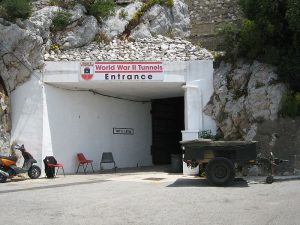
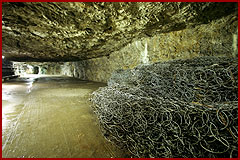 the road had been long and hard, the time spent at the Rock of Gibraltar meant safety, medical care, food, and warmth. It meant being able to let their family know that they were alive. It meant being able to go back to life, and maybe for some, to be able to live to fight another day. As the men were told upon arrival at the Rock of Gibraltar, “Welcome back to the war.”
the road had been long and hard, the time spent at the Rock of Gibraltar meant safety, medical care, food, and warmth. It meant being able to let their family know that they were alive. It meant being able to go back to life, and maybe for some, to be able to live to fight another day. As the men were told upon arrival at the Rock of Gibraltar, “Welcome back to the war.”
 Whenever I come across a book about World War II, and especially about a B-17 Bomber, I want to read it. That subject holds my interest mostly because my dad, Allen Spencer was a top turret gunner and flight engineer on a B-17 bomber stationed at Great Ashfield, Suffolk, England. Lately, I have been “reading” by way of Audible.com, and I must say that having a book read to you, allows you to sit back and enjoy it as if you were watching it unfold before your very eyes. So, when I came across a book called The Lost Airman written by Seth Meyerowitz, I knew I had to hear about it. As the true story began, I found that Arthur Meyerowitz (Seth Meyerowitz’ grandfather) could have been my own dad…at least to the extent that both of them were in the Eight Air Force stationed in England. Arthur was assigned to a B-24 Liberator. At first their experiences were probably almost identical. Arriving at his base, Arthur heard the men who had been there a while, tease the newcomers with things like “You’ll be sorry you came here” or “Look, fresh meat.” I can only imagine how that kind of thing must have felt to the new and often very young airmen…like a swift kick in the gut!! Then the book went on to tell how the airmen felt on their first mission, when no one could eat breakfast, because of the churning in their stomach. Arthur was the flight engineer and top turret gunner, just like my dad had been. It was the job of the flight engineer to check the plane over to ensure that it was fight worthy, and report to the captain. Arthur found problems with their plane, Harmful Lil Armful, and told his captain it needed repairs, but his captain wouldn’t hear of it. He was close to going home, and wanted his last mission out of the way, and besides what did this “newbie” know. He was only on his second mission, and he was filling in for someone else. So, they took off…a catastrophic decision.
Whenever I come across a book about World War II, and especially about a B-17 Bomber, I want to read it. That subject holds my interest mostly because my dad, Allen Spencer was a top turret gunner and flight engineer on a B-17 bomber stationed at Great Ashfield, Suffolk, England. Lately, I have been “reading” by way of Audible.com, and I must say that having a book read to you, allows you to sit back and enjoy it as if you were watching it unfold before your very eyes. So, when I came across a book called The Lost Airman written by Seth Meyerowitz, I knew I had to hear about it. As the true story began, I found that Arthur Meyerowitz (Seth Meyerowitz’ grandfather) could have been my own dad…at least to the extent that both of them were in the Eight Air Force stationed in England. Arthur was assigned to a B-24 Liberator. At first their experiences were probably almost identical. Arriving at his base, Arthur heard the men who had been there a while, tease the newcomers with things like “You’ll be sorry you came here” or “Look, fresh meat.” I can only imagine how that kind of thing must have felt to the new and often very young airmen…like a swift kick in the gut!! Then the book went on to tell how the airmen felt on their first mission, when no one could eat breakfast, because of the churning in their stomach. Arthur was the flight engineer and top turret gunner, just like my dad had been. It was the job of the flight engineer to check the plane over to ensure that it was fight worthy, and report to the captain. Arthur found problems with their plane, Harmful Lil Armful, and told his captain it needed repairs, but his captain wouldn’t hear of it. He was close to going home, and wanted his last mission out of the way, and besides what did this “newbie” know. He was only on his second mission, and he was filling in for someone else. So, they took off…a catastrophic decision.
This was where and similarities between Arthur’s experiences, and those of my dad ended, because my dad was not shot down like Arthur’s plane was. At the point Arthur’s plane was going down, his pilot and co-pilot showed incredible cowardice, and abandoned the plane first…something that was just not done. Arthur tried to 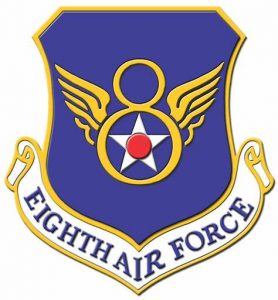 make sure everyone was off, but in the end, one man was stuck and injured. He told Arthur to go and take the newcomer with him, but the newcomer wouldn’t go. He fought Arthur, and actually kicked him off the plane, physically. As Arthur fell, he was sickened by the fact that his pilot and co-pilot jumped first, and that his friends would not be coming home. The pilot and co-pilot spent the rest of the war in a prison camp, but the outcome for Arthur was different, and in fact, miraculous, in more ways than one, because Arthur was not only an airman in the US Army Air Forces, but he was also a Jewish man facing the Nazis in World War II…a perilous place to be.
make sure everyone was off, but in the end, one man was stuck and injured. He told Arthur to go and take the newcomer with him, but the newcomer wouldn’t go. He fought Arthur, and actually kicked him off the plane, physically. As Arthur fell, he was sickened by the fact that his pilot and co-pilot jumped first, and that his friends would not be coming home. The pilot and co-pilot spent the rest of the war in a prison camp, but the outcome for Arthur was different, and in fact, miraculous, in more ways than one, because Arthur was not only an airman in the US Army Air Forces, but he was also a Jewish man facing the Nazis in World War II…a perilous place to be.
It was at this point in the book that my interest in it changed, because this could have been the fate of my dad, had his plane been shot down, but it hadn’t. While the outcome for Arthur was better than that of his crew mates, he still went through a harrowing experience, as did those who helped him. Arthur came down in occupied France on December 31, 1943, and in his landing, he badly hurt his back. From that point on, Arthur came in contact with some of the most amazing people on earth in that or any other time. The French resistance network took Arthur in, and over the next six months, they slowly smuggled him and a British Airman out through Spain to the Rock of Gibraltar. These people did this with precision and secrecy. They knew that if they were caught, they would be killed, but they hated the Nazis, and would do anything to fight against the Nazi regime…right up to, and for some, including giving their lives. The chances they took and the hardships they faced…voluntarily, were so far above and beyond the call of duty, that it almost seemed like a fictional movie. You know, the kind where the good guys always win, and the bad guys always lose. Nevertheless, this wasn’t a fictional movie, and the lives lost were real, but Arthur 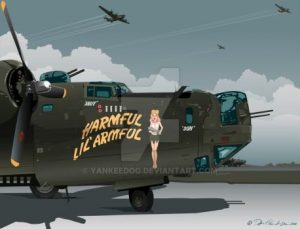 Meyerowitz was not among the lives lost. His was saved because of the selfless acts of so many people in the French Resistance. The story of Arthur Meyerowitz was, for me, so moving that in the end, I cried, and throughout the book, there were moments that I could hardly breathe with the tension of the situations they found themselves in. I felt bad to think it, but I was so thankful that my dad’s B-17 always made it home, and he never had to face the prison camps, or try to escape from a hostile nation. For Arthur, his escape was miraculous, and I believe it was because of the fervent prayers of his family and the undying faith of his mother, who believed that God would bring her son home…and God did.
Meyerowitz was not among the lives lost. His was saved because of the selfless acts of so many people in the French Resistance. The story of Arthur Meyerowitz was, for me, so moving that in the end, I cried, and throughout the book, there were moments that I could hardly breathe with the tension of the situations they found themselves in. I felt bad to think it, but I was so thankful that my dad’s B-17 always made it home, and he never had to face the prison camps, or try to escape from a hostile nation. For Arthur, his escape was miraculous, and I believe it was because of the fervent prayers of his family and the undying faith of his mother, who believed that God would bring her son home…and God did.
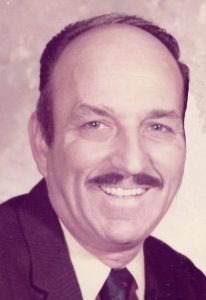
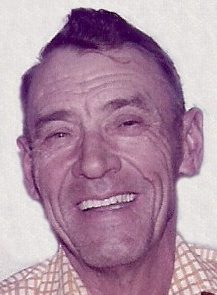
 Since both of my dads, Al Spencer (my dad) and Walt Schulenberg (my father-in-law) are in Heaven now, I don’t have a dad on Earth to celebrate with, but my husband, Bob Schulenberg is still with us…eight months after suffering a heart attack, and receiving miracle care and a miracle healing, and for that, my family and I rejoice and praise God, every day. This year could have been very different, and yet God stepped in and made a way for us. That is my biggest reason to celebrate this Father’s Day. Every day beyond October 14, 2018, is a gift. A precious gift from God. So to my husband, I wish a very special Father’s Day. I am so thankful that you are still with us.
Since both of my dads, Al Spencer (my dad) and Walt Schulenberg (my father-in-law) are in Heaven now, I don’t have a dad on Earth to celebrate with, but my husband, Bob Schulenberg is still with us…eight months after suffering a heart attack, and receiving miracle care and a miracle healing, and for that, my family and I rejoice and praise God, every day. This year could have been very different, and yet God stepped in and made a way for us. That is my biggest reason to celebrate this Father’s Day. Every day beyond October 14, 2018, is a gift. A precious gift from God. So to my husband, I wish a very special Father’s Day. I am so thankful that you are still with us.
The example my dad and my father-in-law set for their children is one of kindness and love. It is an example that we all try to follow, because they were both great family leaders. They were hard working, and took care of their families so that they never wanted for anything. Having a great dad is not automatic…unfortunately. As the saying goes, “Any man can be a father, but it takes someone very special to be a dad.” It takes someone very special to be there through thick and thin…when their children are being good and when they are being bad. Children need to know that no matter what mistakes they make, their parents will always love and support them as they work through life’s ups and downs. Growing up is hard, and we don’t always make that journey smoothly. It is a road often filled with big rock and pot holes. We stumble along, and if there is no one there to pick us up and put us back on out feet, things don’t always go very well. I am so thankful for my two dads, who were good dads to me and my siblings, and well as Bob and his siblings. I firmly believe that it was because of them that Bob and I became the parents we are.
I also feel very blessed that my daughters, Corrie and Amy have been blessed with the wonderful husbands they have. Kevin and Travis are the kid of dads I would have wanted for my girls and their children, if I could have picked. Thankfully, God chose these men for my girls, and I an very proud of the families they have 
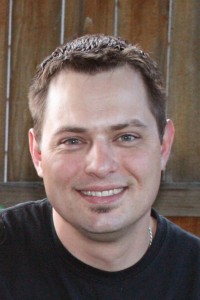
 raised. Their homes are filled with love and much laughter, as well and encouragement and forgiveness. Their children know that their parents are there for them, no matter what. Now the next generation are coming into the age to have kids, beginning with Corrie and Kevin’s son, Chris, who is taking the lessons he learned from his parents, and applying them to his own daughter. Chris is a great dad, and I know that he will raise great kids. Happy Father’s Day to my guys, and all the dads out there!!
raised. Their homes are filled with love and much laughter, as well and encouragement and forgiveness. Their children know that their parents are there for them, no matter what. Now the next generation are coming into the age to have kids, beginning with Corrie and Kevin’s son, Chris, who is taking the lessons he learned from his parents, and applying them to his own daughter. Chris is a great dad, and I know that he will raise great kids. Happy Father’s Day to my guys, and all the dads out there!!
 My grandfather, George Byer was a man of gentle strength. Many people may not think those to traits go together, but in him they did. He was always a hard-working man, who gave his all to support his family, but maybe the gentleness came partly from the fact that he had 9 children, 7 of whom were girls. That can make a man understand that girls are often the fairer gender, at least in those days. Grandpa Byer lived in a time when the women stayed home and raised the family and the men went out and made the living…even if that meant working long hours or multiple jobs. Grandpa also lived during the great depression, when jobs were scarce, so the women need not have bothered to go look for one very often.
My grandfather, George Byer was a man of gentle strength. Many people may not think those to traits go together, but in him they did. He was always a hard-working man, who gave his all to support his family, but maybe the gentleness came partly from the fact that he had 9 children, 7 of whom were girls. That can make a man understand that girls are often the fairer gender, at least in those days. Grandpa Byer lived in a time when the women stayed home and raised the family and the men went out and made the living…even if that meant working long hours or multiple jobs. Grandpa also lived during the great depression, when jobs were scarce, so the women need not have bothered to go look for one very often.
While times were tough sometimes, the family really never wanted for much, and grandma, Hattie Byer could somehow make the meager portions of food go a long way, and still never turn 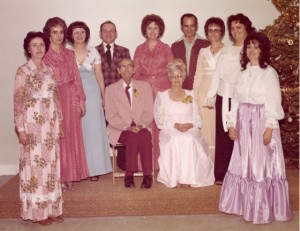 away a stranger in need of a meal, and it seemed there was always a plentiful supply of those strangers and friends who would come for dinner at the Byer house. They were a good team, and truth be told, Grandma Byer was probably just as tough, if not more so than Grandpa Byer, who did have a definite soft spot in his heart for people. Grandpa worked at a number of jobs, but the one I probably heard the most about was the building of Alcova Dam Grandpa had also worked on Kortez Dam and Pathfinder Dam, but my mom, Collene Spencer, who was Grandpa’s middle child, always mentioned to us that her dad had helped build Alcova Dam, every time we drove past it. She was very proud of her dad, and with good reason, because he was very special.
away a stranger in need of a meal, and it seemed there was always a plentiful supply of those strangers and friends who would come for dinner at the Byer house. They were a good team, and truth be told, Grandma Byer was probably just as tough, if not more so than Grandpa Byer, who did have a definite soft spot in his heart for people. Grandpa worked at a number of jobs, but the one I probably heard the most about was the building of Alcova Dam Grandpa had also worked on Kortez Dam and Pathfinder Dam, but my mom, Collene Spencer, who was Grandpa’s middle child, always mentioned to us that her dad had helped build Alcova Dam, every time we drove past it. She was very proud of her dad, and with good reason, because he was very special.
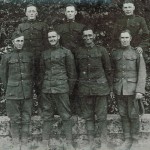 Grandpa served in the Army during World War I as a cook. While he was very brave, and never a man to shirk his duties, I think it would have been hard for this gentle soul to have a military career of killing people. Nevertheless, had the need arisen, he would have done it, because he always knew that he would protect those in his charge. He was a very loyal soldier, and he would never have allowed those he cared about to be killed, if he could stop it. His gentle strength was, for me, his trademark trait. I remember it from my childhood as clearly as if Grandpa Byer were standing right next to me as I write this story. he was the sweetest, kindest, most gentle man anyone could have known. Today would have been my Grandpa Byer’s 126th birthday. Happy birthday in Heaven, Grandpa. We love and miss you very much!!
Grandpa served in the Army during World War I as a cook. While he was very brave, and never a man to shirk his duties, I think it would have been hard for this gentle soul to have a military career of killing people. Nevertheless, had the need arisen, he would have done it, because he always knew that he would protect those in his charge. He was a very loyal soldier, and he would never have allowed those he cared about to be killed, if he could stop it. His gentle strength was, for me, his trademark trait. I remember it from my childhood as clearly as if Grandpa Byer were standing right next to me as I write this story. he was the sweetest, kindest, most gentle man anyone could have known. Today would have been my Grandpa Byer’s 126th birthday. Happy birthday in Heaven, Grandpa. We love and miss you very much!!

 My grand nephew, James Renville has been working hard, going to college, and living at home with his mom, Toni Chase and step-dad, Dave Chase. It has been a good way to go for James, because he attended Casper College, and his parents live in Casper, so why pay for a dorm or apartment. James and his parents get along very well, so it has worked out nicely. In addition, living at home gives James’ the ability to enjoy the family dog, which he could not have in a dorm or in most apartments. James has always had a dogs, and right now they Biscuit and Cricket, and they would be lonely without James.
My grand nephew, James Renville has been working hard, going to college, and living at home with his mom, Toni Chase and step-dad, Dave Chase. It has been a good way to go for James, because he attended Casper College, and his parents live in Casper, so why pay for a dorm or apartment. James and his parents get along very well, so it has worked out nicely. In addition, living at home gives James’ the ability to enjoy the family dog, which he could not have in a dorm or in most apartments. James has always had a dogs, and right now they Biscuit and Cricket, and they would be lonely without James.
James graduated from college in May, with a degree in Communications and Media. I wasn’t sure just exactly what you can do with that degree, so I did a bit of research. Jobs directly related to your degree include: Media planner, Multimedia specialist, Program researcher, broadcasting/film/video, Public relations officer, broadcasting/film/video, Social media manager, Television/film/video producer, and Web content manager…just to name a few. I’m not sure just exactly what James has in mind for his career, but he has time to explore the great possibilities for career ideas.
James may continue his education, but for right now, he’s taking a break from school. He is working at Home 
 Depot right now, and saving his money, because he wants to travel overseas again. James visited the Netherlands a couple of times, where he has a close friend, and that really gave him the travel bug. His job and living at home allows him to put his money into his travel plans. James has big plans for his life, possibly including moving out of Wyoming, but nothing is set in stone right now, so I guess time will tell. Of course, we hope he doesn’t go too far. Still, the future is wide open, and I’m excited to see where it will take him. Today is James’ birthday. Happy birthday James!! Have a great day!! We love you!!
Depot right now, and saving his money, because he wants to travel overseas again. James visited the Netherlands a couple of times, where he has a close friend, and that really gave him the travel bug. His job and living at home allows him to put his money into his travel plans. James has big plans for his life, possibly including moving out of Wyoming, but nothing is set in stone right now, so I guess time will tell. Of course, we hope he doesn’t go too far. Still, the future is wide open, and I’m excited to see where it will take him. Today is James’ birthday. Happy birthday James!! Have a great day!! We love you!!
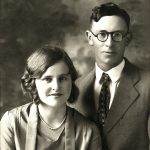 My husband, Bob’s grandparents, Robert and Nettie Knox were married in Forsyth, Montana on this day in 1928. It’s strange how things come to pass. Nettie was born in Clyde Park, Montana, but Robert was born in Prosser, Washington. Had Robert’s family not moved to Montana when he was young, they likely would never have met. Distances back then prevented things like yearly vacations to tour the United States. Nevertheless, like my own Robert, who was born in Miles City, Montana; while I was born in Superior, Wisconsin; and we met in Casper, Wyoming, where both families lived then. Robert Knox and Nettie Noyes both ended up in the Rosebud area, and the rest was history.
My husband, Bob’s grandparents, Robert and Nettie Knox were married in Forsyth, Montana on this day in 1928. It’s strange how things come to pass. Nettie was born in Clyde Park, Montana, but Robert was born in Prosser, Washington. Had Robert’s family not moved to Montana when he was young, they likely would never have met. Distances back then prevented things like yearly vacations to tour the United States. Nevertheless, like my own Robert, who was born in Miles City, Montana; while I was born in Superior, Wisconsin; and we met in Casper, Wyoming, where both families lived then. Robert Knox and Nettie Noyes both ended up in the Rosebud area, and the rest was history.
Grandma always liked to tease grandpa that she was older and wiser than he was…at 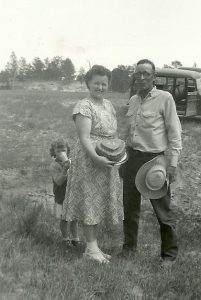 least from June 30th to November 28th, when he caught up to her in years again. It was just one of the ways Grandma liked to tease Grandma. Their marriage would have it’s ups and downs, just like any other marriage. They lost their first child, Everett Knox at birth, and it was then that Grandma decided that any subsequent children would be born in the hospital, not at home. Grandma entered the hospital with my future mother-in-law, 40 days before she was born. Thankfully, $5.00 a day covered her hospital bills. I don’t think she could have been able to afford todays rate just to make sure she had the baby in the hospital. Their daughter, Joann Knox’s birth went off without a hitch, nevertheless, I don’t think Grandma could get comfortable with the idea of having another baby…at lease not for the next 14 years, when she got pregnant with their daughter, Linda, who’s birth also went off without a hitch. Margaret “Margee” would follow just a little over two years later, and their family was complete. Nevertheless, Grandma’s belief that her son would have survived, had she been delivered by Caesarean Section, prompted her to distrust home-births for the rest of her life. Grandma and Grandpa Knox, went on to have 8 grandchildren; each of them
least from June 30th to November 28th, when he caught up to her in years again. It was just one of the ways Grandma liked to tease Grandma. Their marriage would have it’s ups and downs, just like any other marriage. They lost their first child, Everett Knox at birth, and it was then that Grandma decided that any subsequent children would be born in the hospital, not at home. Grandma entered the hospital with my future mother-in-law, 40 days before she was born. Thankfully, $5.00 a day covered her hospital bills. I don’t think she could have been able to afford todays rate just to make sure she had the baby in the hospital. Their daughter, Joann Knox’s birth went off without a hitch, nevertheless, I don’t think Grandma could get comfortable with the idea of having another baby…at lease not for the next 14 years, when she got pregnant with their daughter, Linda, who’s birth also went off without a hitch. Margaret “Margee” would follow just a little over two years later, and their family was complete. Nevertheless, Grandma’s belief that her son would have survived, had she been delivered by Caesarean Section, prompted her to distrust home-births for the rest of her life. Grandma and Grandpa Knox, went on to have 8 grandchildren; each of them 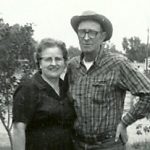 having a granddaughter born on their birthday…Corrie on Grandma’s birthday, and Machelle on Grandpa’s.
having a granddaughter born on their birthday…Corrie on Grandma’s birthday, and Machelle on Grandpa’s.
Married life wasn’t always easy for them. They lived through many tough times in their own life, as well as, economic times. Nevertheless, they persevered, and their marriage lasted until Grandpa’s passing in 1985. Grandma never really wanted to continue on after his passing, but she stuck it out until 1990. If they were still alive today, which wul have put them in their 110s, they would have been married 91 years today. I know they are celebrating in Heaven. Happy 91st Anniversary Grandma and Grandpa Knox. We love and miss you very much.

